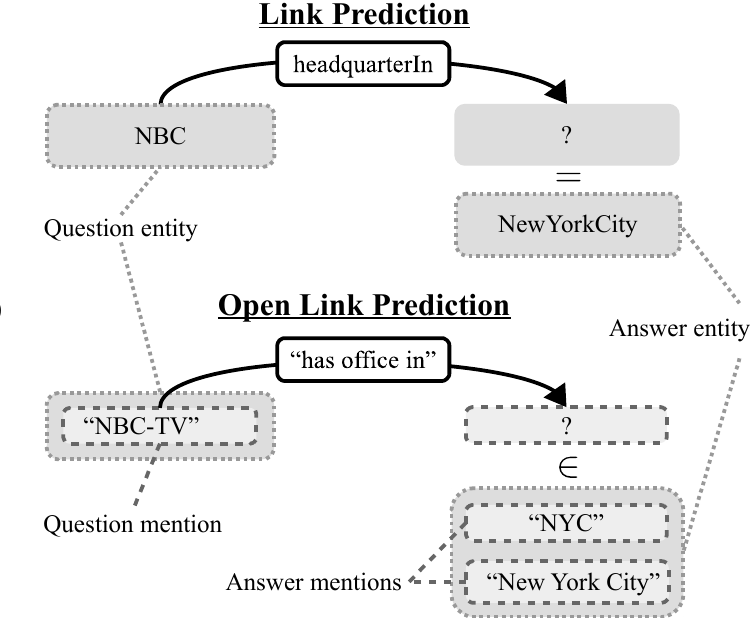This repository contains the code for the ACL 2020 paper "Can We Predict New Facts with Open Knowledge Graph Embeddings? A Benchmark for Open Link Prediction". The code provides the means to train open knowledge graph embeddings and the code that was used to create the benchmark OLPBENCH. The code is provided as a documentation for the paper and also for follow-up research.
The content of this page covers the following topics:
- Preparation and Installation
- Training an Open Knowledge Graph Embedding Model on OLPBENCH
- Create OLPBENCH from scratch
-
The project is installed as follows:
git clone https://github.com/samuelbroscheit/open_link_prediction_benchmark.git cd open_link_prediction_benchmark pip install -r requirements.txt -
Add paths to environment
source setup_paths -
Download OLPBENCH
Download the full dataset (compressed: ~ 2.4 GB, uncompressed: ~ 7.9 GB)
cd data wget http://data.dws.informatik.uni-mannheim.de/olpbench/olpbench.tar.gz tar xzf olpbench.tar.gz cd ..
Once preparation and installation are finished you can train a model on OLPBENCH.
Run the training with:
python scripts/train.py [TRAIN_CONFIG_YAML] [OPTIONS]
TRAIN_CONFIG_YAML is a yaml config file. The possible options are documented in:
All top level options can also be set on the command line and override the yaml confguration.
If you run training on a dataset the first time some indexes will be created and cached. For OLPBENCH this can take around 30 minutes and up to 10-20 GB of main memory! After the cached files are created the startup takes under 1 minute.
A token-based model for the OLPBench benchmark.
- config/acl2020-openlink/wikiopenlink-thorough-complex-lstm.yaml is a configuration to train a OpenKGE model on the open link benchmark data.
Two example models for the the Freebase FB15k-237 benchmark. Suggested for prototyping token based models.
An example standard KGE model for the the Freebase FB15k-237 benchmark.
Run evaluation after training on test data with:
python scripts/train.py --resume data/experiments/.../checkpoint.pth.tar --evaluate True --evaluate_on_validation False
--resume expects the path to a checkpoint file. Checkpoints of the current state and also the best model(s) w.r.t. a model selection metric are saved during training.
--evaluate_on_validation False sets the evaluation to run on test data
See openkge/model.py
- LookupTucker3RelationModel
- LookupDistmultRelationModel
- LookupComplexRelationModel
- UnigramPoolingComplexRelationModel
- BigramPoolingComplexRelationModel
- LSTMDistmultRelationModel
- LSTMComplexRelationModel
- LSTMTucker3RelationModel
- DataBiasOnlyEntityModel
- DataBiasOnlyRelationModel
For model options see the init of the respective class in openkge/model.py. Additional to the combinations above, new combinations of score and embedding functions can be easily created by:
class BigramPoolingDistmultRelationModel(DistmultRelationScorer, BigramPoolingRelationEmbedder):
def __init__(self, **kwargs):
super().__init__(**kwargs)
ONLY if you want to create OLPENCH or a variant of it from scratch! This takes around half a day and a lot of memory to run. Best setting is at minimum a 40 core machine with at least 64GB of free main memory.
Download the OPIEC clean dataset (compressed: ~ 35 GB, uncompressed: ~ 292.4 GB)
cd data
wget http://data.dws.informatik.uni-mannheim.de/opiec/OPIEC-Clean.zip
unzip OPIEC-Clean.zip
cd ..
Then download and start an Elasticsearch server, that should listen on localhost:9200 . This is usually as easy as downloading the most recent version, unzip it in some folder, then change the default configuration to
cluster node.local: true # disable network
and then start the server in with ./bin/elasticsearch. Then run the preprocessing with
python scripts/create_data.py -c config/preprocessing/prototype.yaml
-
config/preprocessing/prototype.yaml a configuration for prototyping the pipeline
-
config/preprocessing/acl2020.yaml the configurations with the settings from the ACL2020 study
cd data/fb15k237
python prepare_fb237.py
A token-based model:
-
config/fb15k237/fb15k237-complex-lstm.yaml is a configuration to train a OpenKGE model on FB15k237 using token descriptions of the data.
-
config/fb15k237/fb15k237-complex-kge.yaml is a configuration to train a OpenKGE model on FB15k237 using standard KGE lookup embeddings of the data.
This is additional information about how a triple was extracted. For example, has:impl_poss-clause was extracted from a sentence which did not explicitly say "New York has a mayor ...", but from a implicit possessive relation, similar to a construction in "New York's mayor ...". OLPBENCH is based on OPIEC (https://openreview.net/forum?id=HJxeGb5pTm) which was created with the system MINIE (see Implicit extractions in https://aclanthology.org/D17-1278.pdf), which uses the patterns described in FINET (https://aclanthology.org/D15-1103.pdf). Check out the last two papers to learn more about the implicit extractions that can occur in this dataset. Some of those patterns can be noisy and therefore might require special treatment, which is why this information is present in the data. For instance, for the evaluation data we chose the heuristic to sample only from relations with three or more words. This automatically excluded some implicit extractions for evaluation. If a model cannot handle this additional information then a simple approach is to just ignore everything after the colon. In our work we treated has:impl_poss-clause as a different token from has.
if you find this code useful for your research please cite
@inproceedings{broscheit-etal-2020-predict,
title = "Can We Predict New Facts with Open Knowledge Graph Embeddings? A Benchmark for Open Link Prediction",
author = "Broscheit, Samuel and
Gashteovski, Kiril and
Wang, Yanjie and
Gemulla, Rainer",
booktitle = "Proceedings of the 58th Annual Meeting of the Association for Computational Linguistics",
month = jul,
year = "2020",
address = "Online",
publisher = "Association for Computational Linguistics",
url = "https://www.aclweb.org/anthology/2020.acl-main.209",
doi = "10.18653/v1/2020.acl-main.209",
pages = "2296--2308",
}
